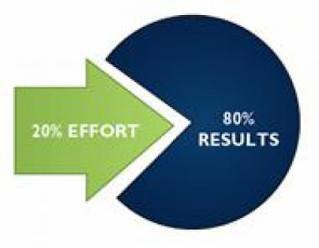In 1897, Vilfredo Pareto, and Italian economist, observed that the distribution of wealth was unequal within every country. That is, 5% of the population might own 50% of the wealth, 10% of the population might have 65% and 20% might own 80%. Whilst this is not very remarkable (we see it all the time) what Pareto discovered was that this pattern repeated itself in almost every country he examined.[i] Consequently, he concluded that there was a predictable mathematical relationship at work that determined the distribution of wealth: in short, 20% of the population would hold 80% of the wealth.
Since Pareto, many other academics have observed this phenomenon in other aspects of life. They have found generally that 80% of the results of something usually come from 20% of the efforts. To clarify, it is neither the first 20% nor the last 20% of efforts that produces the 80% of results, but rather it is distributed amongst all the effort. If we could easily identify the 20% that produces the results, we would probably try to concentrate on it and eliminate the inefficient 80%. The dilemma, of course, is that we can’t quite put our finger on those high-valued activities that create the biggest pay-off.
Think about some of ways you can observe the Pareto principle in your own life. For example:
- 20% of your investment portfolio returns about 80% of the capital gains while the other 80% of your investments make up only 20% of your gains (if you could just predict those producers you could have retired by now).
- 20% of your effort at work results in 80% of your achievement while the other 80% makes up only 20% of your achievement (knowing which effort will be rewarded would let you go home early).
- 20% of your sales leads return 80% of your future revenue while the other 80% lead to only 20% of revenue (concentrating on those 20% would save you dramatically, if you knew who they were).
- 20% of your employees’ effort results in 80% of the output while 80% of their effort only produces 20% of the output (if you don’t believe this, just watch them for a few days).
- 20% of your employees produce 80% of the value-added work while 80% of your employees produce only 20% of the value-added work (we call these people “stars,”, and they do not usually stick around when they realize that their pay is not commensurate).
- 20% of your employees will create 80% of the unnecessary work while 80% will create only 20% of the unnecessary work (just go to a big corporation and look to see how many committee meetings there are).
- 20% of your customers make up 80% of your complaints while the other 80% only make up 20% of the complaints (is there something in common with these people and can you do something quick to resolve the matter?).
- 20% of your time on the phone is spent with 80% of your clients while the other 80% is only spent with 20% of you customers (are these the right 20% you want to spend time with?).
- 20% of “value” comes from 80% of your customers while the other 80% of the value comes from only 20% of your customers.
If you would like to evaluate the Pareto Principle in your business, do not hesitate to contact us for professional advice in this regard.
© 2020 Nexia SAB&T. ALL Rights Reserved. Nexia SAB&T is a member of Nexia International, a leading, global network of independent accounting and consulting firms that are members of Nexia International Limited. Nexia International Limited, a company registered in the Isle of Man, does not provide services to clients. Please see the “Member firm disclaimer” for further details.

